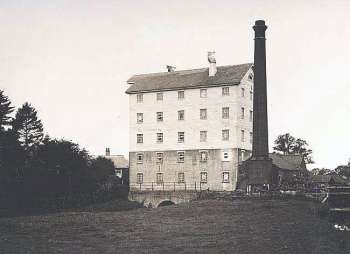 |
|
c.1900
|
|
Gt. Ryburgh Mill
River Wensum |
 |
|
c.1900
|
|
Great Ryburgh
had a mill listed in Domesday, when the mill, which is specifically mentioned,
formed part of the Lordship of Reienburgh and belonged to Peter de Valoins
and was held by Radulfus Facto. This mill however, was almost certainly the earlier Southmylle. When the Mill House was constructed, it was built directly onto the Southmylle site. |
|
It is not clear when Southmylle ceased working and the new and larger mill was built. |
|
The later mill was 5 storeys high and built of weatherboard over a brick base and had a pantiled roof. |
 |
Goodes cattalle, and implementes of household sould by Thom^s Buttes of Greate Riburgh within the Countie of Norff Esquier, to Sir Nicholas Bacon of Redgrave in the Countie of Suff, Knighte The first daie of November in the Sixxe & twentie yere of the Raigne of our Soverigne Ladie Quene Elizabeth &c at greate Riburgh aforesayd to the prises underwritten. |
Buttes a/cs 1584 BL Add Mss 39227 f116 - 1584 |
 |
|
In the millehouse & div^se other places |
Item two mille stones conteyning\ in Bredeth L inches & in thicknes |
Buttes a/cs 1584 BL Add Mss 39227 f116v - 1584 |
|
In the Name of God Amen |
Royal Exchange Fire Insurance policy 74227 |
Jno. Butcher of Ryborough Magna in the County of Norfolk, Miller. On Furniture in his Dwelling House, Water Corn Mill & Offices adjoining brick built & tiled, situate in Ryborough Magna aforesd., £100. On Utensils & Goods in Trade in the same, £400. 10th November 1778 |
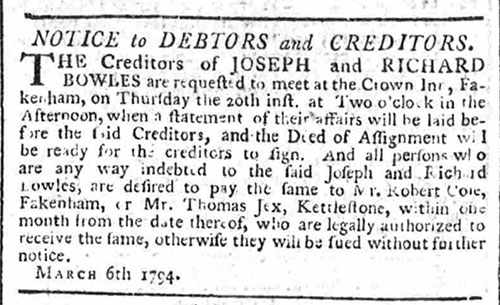 |
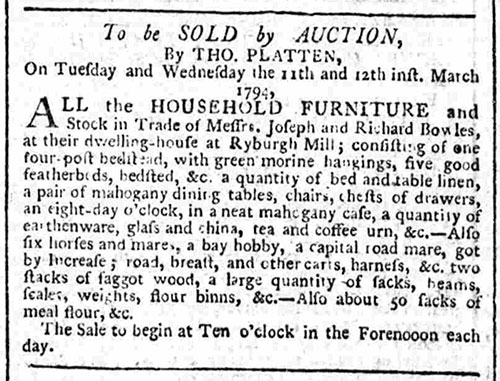 |
Norfolk Chronicle - March 1794 |
Norfolk Chronicle - March 1794 |
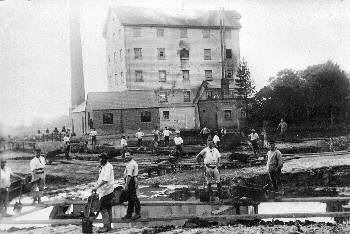 |
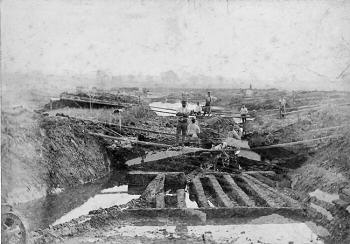 |
|
5th
September 1893
|
10th
November 1893 |
 |
Mill sale announcement - 1846 |
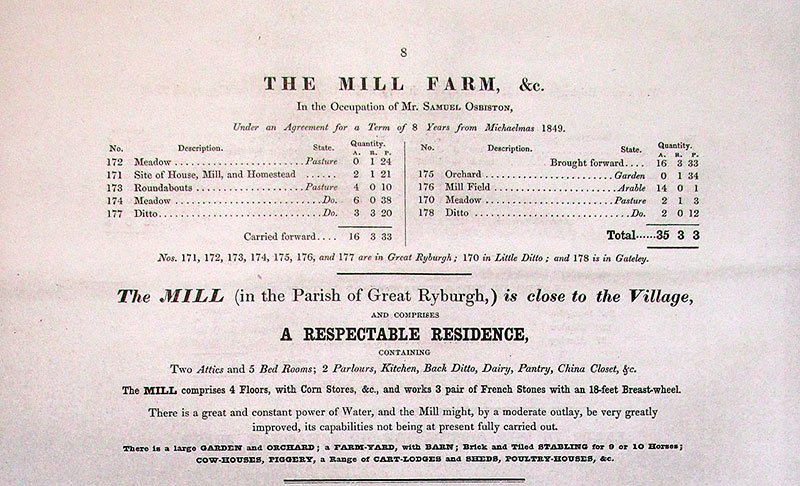 |
Mill & house sale - 1850 |
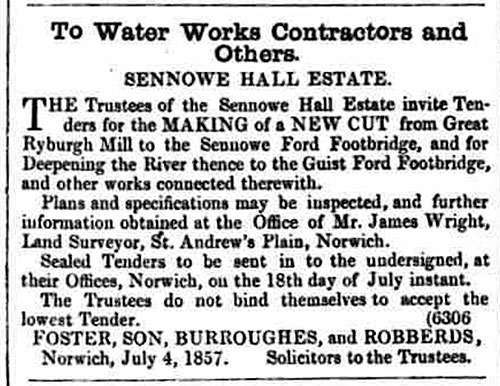 |
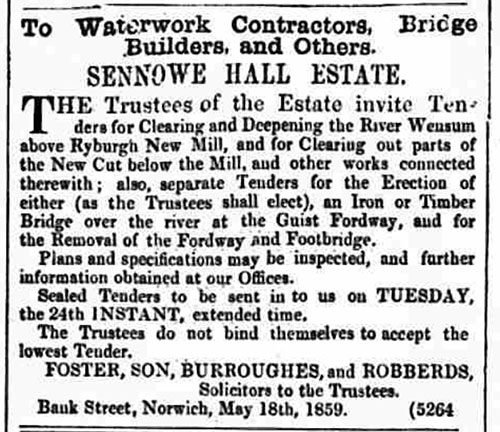 |
Norwich Mercury 1857 |
Norwich Mercury - May 1859 |
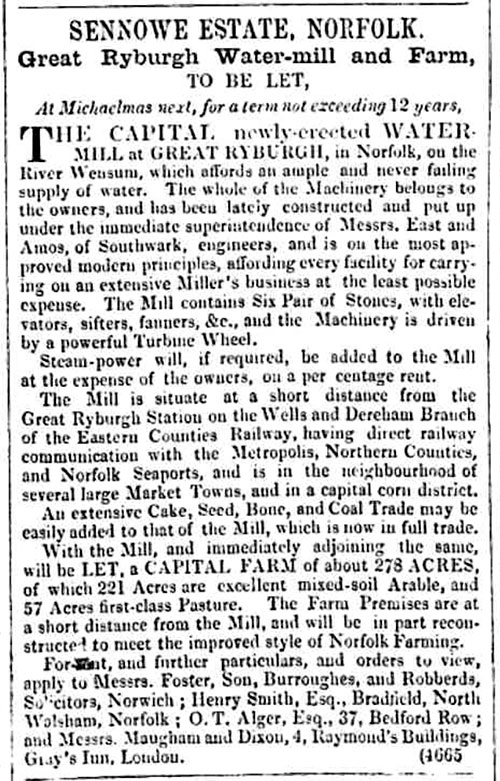 |
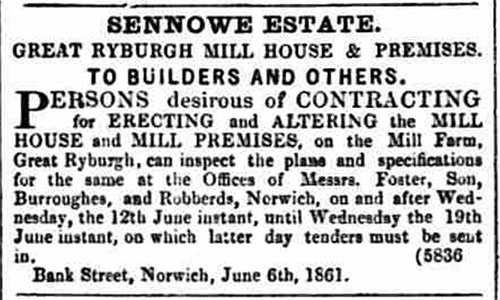 |
Norwich Mercury - 12th May 1860 |
Norwich Mercury - June 1860 |
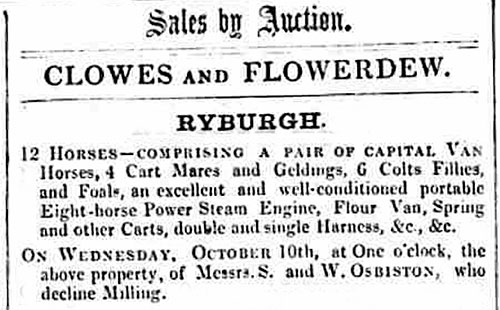 |
Norwich Mercury - September 1860 |
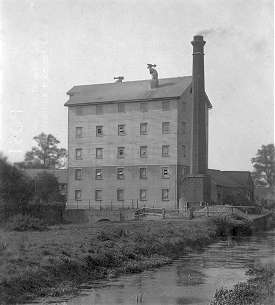 |
|
c.1907 with steam engine running |
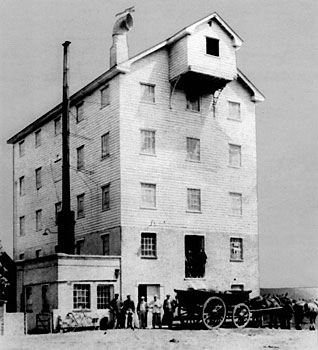 |
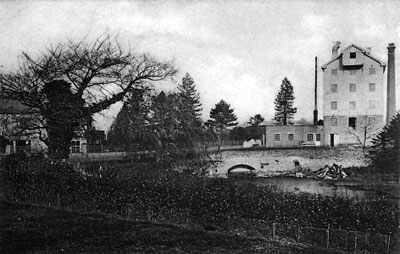 |
|
c.1900
|
c.1905 with extended single storey unit |
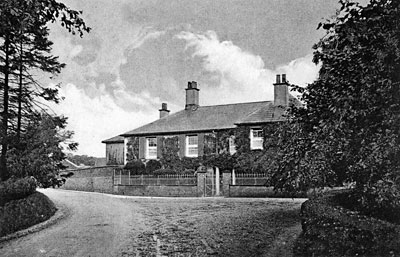 |
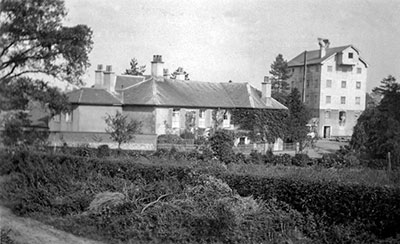 |
Mill House c.1910 |
Mill House c.1925 |
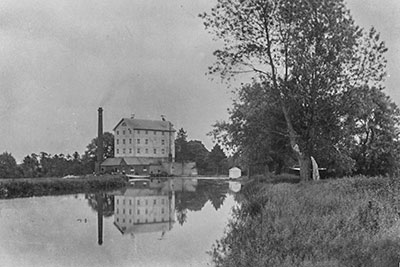 |
 |
Steam engine running c.1910 |
Mill dam c.1910 |
 |
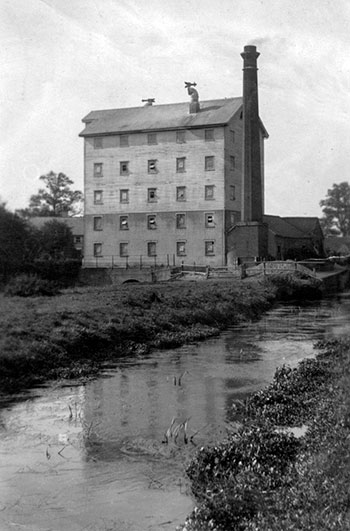 |
c.1910 |
Steam engine running c.1914 |
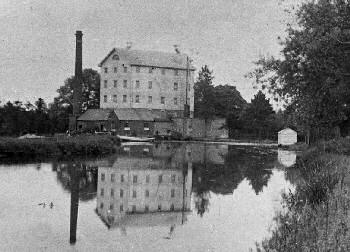 |
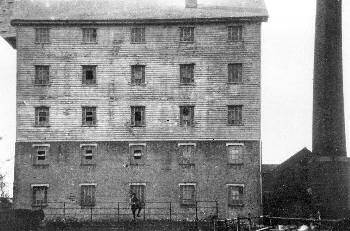 |
|
c.1915 |
1918 |
|
In 1579 it was leased to Simon Mussett, together with the Mill House called 'Southemylle', with all the going gear, one messuage called 'Millies' near the mill, one yard called 'Newsteade Yard' and one parcel of morishe (marsh) land to the east of the mill, for seven years at a yearly rent of £13 6s 8d. The Lessor was bound to grind at the mill. The lessee left an overstone and one netherstone of certain sizes and agreed not to fish in any part of the dam, river or stream that runs to the mill, except that he may take eels and other fish at the 'Owteloades' of the mill or millwheel with shakenets, with a proportion of the eels and fish being given to the lessor. The mill continued in the Bacon family until the year 1760, when on the death of Mary Bacon who was a spinster, it passed to her nephew Thomas Wodehouse, the youngest son of Sir Armine Wodehouse. In about 1800 the mill passed to the Boycott family. |
In 1809 Thomas Wodehouse filed an Enclosure Claim for one other messuage, with a water-mill and one hundred and sixteen acres by estimation of land in Great Ryburgh aforesaid, in the occupation of Mr. Thomas Fowell. |
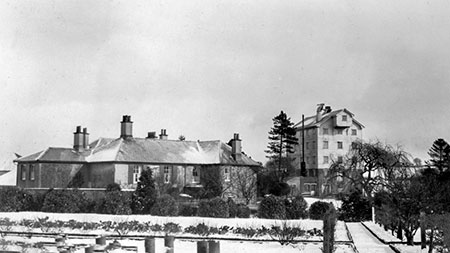 |
|
Mill House and Mill c.1932 |
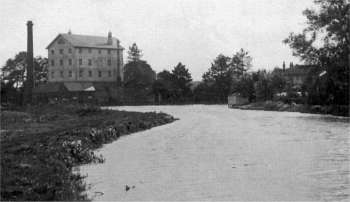 |
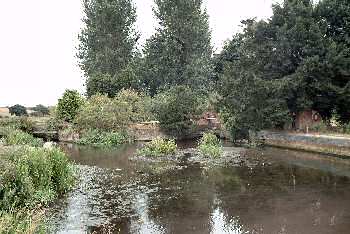 |
|
c.1910 with full dam |
25th August 2003 |
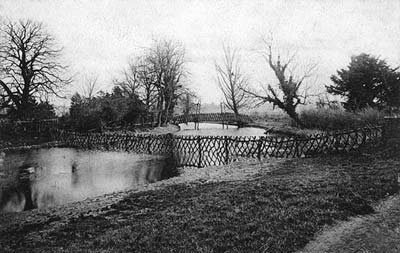 |
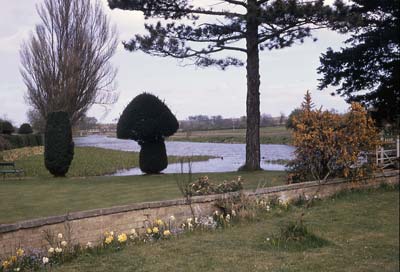 |
Mill dam c.1930 |
Mill dam April 1967 |
Flour Mill and Farm. |
To be Lett, and entered upon on the 10th Day of October next, a Water Mill,
which for many Years past has been used in the Flour Trade; it stands on a
very good Stream. The Dwelling House Brick and Tile, handsome and convenient
built not many Years ago, with Offices of every Kind; and a Farm, containing
235 Acres of Good Land, Meadow and Pasture, in Great Ryburgh, and Gately, in
the County of Norfolk, much the greatest Part of which is Tythe free,
and subject only to a Modus of 1 pound 2 shillings and 6 pence to the
Rector of Ryburgh, and another Modus of 2 shillings 6 pence to Gately. Further Particulars may be had of Mr Seth MASTERS of Walsingham, or of Jehosaphat POSTLE, on the Castlemeadow, at Norwich. Norfolk Chronicle - 7th July 1781 |
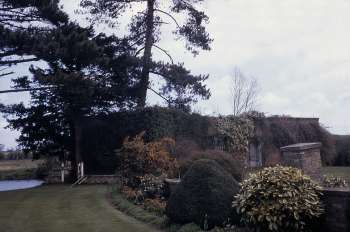 |
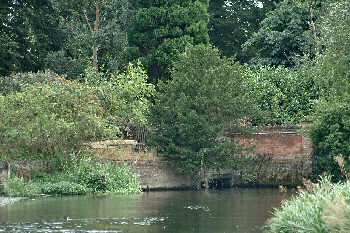 |
|
March 1967
|
Remains of the brick base 25th August 2003 |
The report of Mr. C. I. Watts as to engine repairs for the Ryburgh Mill was read and it was decided to put down a first class engine and Galloway boiler capable of driving a four sack roller plant independent of water power and that Messrs. Richard and Watts, Turner & Son, Holmes & Sons Ltd., and Ransommes, Simms and Jefferies be invited to supply specifications and estimates for the same. |
|
The steam engine was eventually supplied by Holmes & Son with its installation supervised by C. Watts. Whitmore & Binyon installed a new roller plant for £2,000 and a wheat dryer for £145. |
Messrs F & G Smith Limited In the pretty village of Ryburgh Magna, which is on the western bank of the river Wensum, four miles south-east of Fakenham, we had the pleasure of spending a day last month, in order to see the start of a new roller mill that has been erected by the well-known milling engineers, Messrs Whitmore & Binyon, of 64 Mark Lane, London, EC, and the Iron Works, Wickham Market, Suffolk, for Messrs F & G Smith Limited, who are known as the largest maltsters in East Anglia, and who have also worked a millstone mill for 30 years at Ryburgh. The history of this millstone mill is indeed identified with the firm of Messrs Whitmore & Binyon, for the old firm Messrs Whitmore & Sons, the predecessors of the present firm, erected this mill as a stone mill 35 years ago, and a most symmetrical and sound piece of work they made of it, a spur gear hurst of six parts of stones being arranged in a complete circle exactly in the middle of the mill and around the turbine shaft, which was extended to the upper floor for driving the various wheat cleaners and flour dressers, forming for that period a most elaborate system. This millstone system which was worked by a turbine fitted in the stream at the time of the alteration has, however, to make way for the more modern roller mill process, but three pairs of the millstones have been retained for whole meal and barley grinding. The mill, which is the property of Messrs F & G Smith Limited, is on the River Wensum and is a fine building, the two bottom floors being of brick and the top floor of wood, as is the construction of many of the mills in Norfolk. The opening of the new mill on the 20th ult was celebrated by a champagne luncheon, at which a goodly company of Norfolk millers and other visitors were present, the feed being turned on previously by Mrs George Smith, the wife of the chairman of the company. After the feed had been turned on, three cheers were called for by Mr W N Whitmore, the senior partner of the firm of Messrs Whitmore and Binyon, which were heartily given, and Mrs Smith acknowledged the compliment in a few words, spoken with a grace and charm which only a lady can display. The company then spent some time in examining the working of the various machines comprising the roller plant, which were placed on the different floors. Roller
Mill Plant Ground
Floor Divided off from the rest of the mill by means of a glass partition are the five double roller mills arranged in a straight line. The wheat is reduced to flour on the system of four breaks and six reductions. The first, second, third and fourth breaks are performed on two double roller mills, each fitted with four grooved chilled iron rolls 24 inches by 9 inches and we noticed that the roller mill, dealing with the third and fourth break material, is fitted with, besides its ordinary feed arrangement, a flight conveyor in the top of the hopper in order to distribute the feed more evenly. The six reductions are effected on two double roller mills, each fitted with four smooth chilled iron rolls 24 inches by 9 inches and a double roller mill, fitted with four chilled iron rolls, 18 inches by 9 inches. In the other portion of the mill are three pairs of millstones for making millstone flour and doing gristing work, and the bottom portion of a new wheat heater, which has recently been patented by Messrs Whitmore and Binyon, and we hope to give a full description, with illustration, of this apparatus in a future issue. Second
Floor Third
Floor Fourth
Floor Fifth
Floor Motive
Power The necessary steam to drive the engine is obtained from a double-flued Galloway boiler, 16 feet long and 6 feet 6 inches in diameter, also put down by the same firm who built the engine. The Luncheon Mr. W N Whitmore, JP, who occupied the vice-chair, and had Mrs George Smith on his right, Messrs Frederick Edgar Smith, Herbert E Smith, Edgar Smith, William Salisbury, W J Perrett (London), H Mower (Norwich), H W Mower (Norwich), B Press (Yarmouth), R Hutchinson (Kirkcaldy, N B), - Papworth (Yarmouth), P Smith (Southwold), C Horsley (Fakenham), John Jackson, Frank Callow, James Rivett, and R W Dunham (The Miller), J W Rush (The Millers' Gazette), and the representative of the East Anglian Daily Times. After the luncheon the usual loyal toast of "The Queen" was given by the chairman, and having been duly honoured, the vice-chairman, Mr W N Whitmore, JP, in a few appropriate observations, proposed the toast of the day, "Health and Prosperity to the Firm of Messrs F & G Smith Limited". They must all, he was sure, be struck by the great amount of success obtained by the firm of Messrs F & G Smith in the commercial work and he (the speaker) felt certain that the mill they had the pleasure of erecting for Messrs F & G Smith, and had seen started by Mrs George Smith that morning, would be handled by them as business men in such a manner that they would hold their own in this time of severe competition. He remembered the time when he was at that same mill in the year 1858, and started the turbine and the new hursting for their mill, and it spoke well for the firm of Messrs Whitmore & Binyon that they had been able to secure the order for the new roller mill that they had that day started. He was so satisfied with the mill that he did not think it was necessary to say anything about the roller mill, as the gentlemen present would have formed some opinion of that, and were better able to say what they thought of that then one who was so interested in the plant as the speaker was. He would merely say that he wished them as he was sure everyone did that was present, prosperity in their new enterprise. The Chairman (Mr George Smith), in responding, expressed belief in the prosperity of the new underisking, because all the practical men of business who had seen the roller mill that day in every way satisfied with it. He said that it was the proudest day of his life to stand there amongst his brother millers and hear their good wishes for their firm's prosperity, and he would conclude by proposing the toast of "Messrs Whitmore & Binyon" to whose engineering reputation he was able to pay a high compliment. After referring to the fact that Messrs Whitmore's firm started in 1788, the chairman mentioned the circumstance of their fitting up the Ryburgh Mill in 1858, when they put in a turbine, and as a testimony to their workmanship, he was able to state that their turbine had never required even looking at from that day to this, and in fact had rarely been seen by those employed in the mills. (Applause.) The directors of the firm with which he was connected spared no pains when thinking of putting in a roller plant, in coming to a conclusion as to which of the number of tenders they received should be accepted. They felt however, after visiting a number of roller mill, that as the old machinery had done such good service, they would not run away from the firm that had supplied it. (Applause.) The Vice-Chairman (Mr W N Whitmore) briefly replied, and after presenting Mrs George Smith with samples of the flour produced from the sample of wheat, alluded in the course of his remarks to the advent of Mr Perrett into the firm of Messrs Whitmore & Binyon, and gave all possible credit to that gentleman for the part he had taken securing the order and carrying it out to such a successful issue. Mr Perrett, whose name was also coupled with the toast, acknowledged the compliment in suitable terms, and at the conclusion of his speech, proposed the health of Mr Salisbury, who has filled the position of manager of the Ryburgh Flour Mills for 32 years. Mr William Salisbury, in thanking the company for the way they had drunk his health, alluded to the present position of the milling trade, and hoped they all should have better times in the near future. The other
toast were "Mr Herbert Smith", "The Visitors", coupled
with the names of Mr B Press, Mr Charles Horsley and Mr Kersley, the "Press",
and "The British Farmer", which were duly responded to. During
the intervals between the speeches songs were rendered by several of those
present, and thus a most enjoyable day came to a close. |
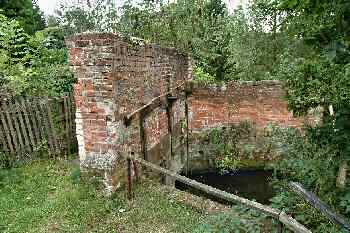 |
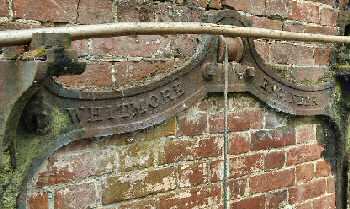 |
|
Wheel sluice 25th August 2003
|
Whitmore & Binyon's sluicegear August 2003 |
|
The ironwork above the wheel sluices bears the cast inscription Whitmore Engineer Wickham Mkt Suffolk |
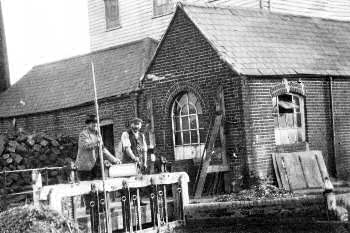 |
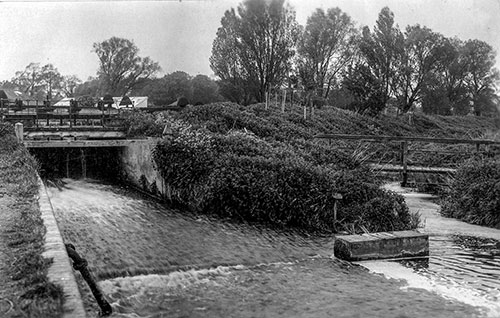 |
|
Bypass sluice in 1918 |
Bypass sluice c.1935 |
 |
Jack Boulter, mill's longest serving employee - 1923 |
Ex-resident Hugh Dawson, remembers standing on the road bridge over the river in 1925 with his father to watch the steam chimney being taken down. Apparently it fell in two sections and landed in the space between the river channels. |
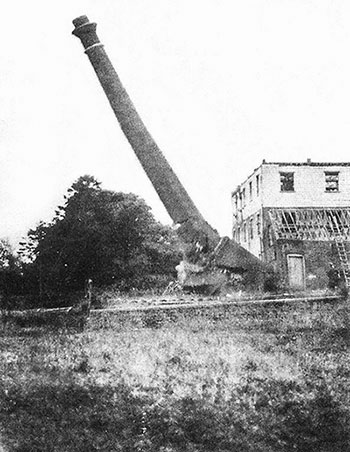 |
|
25th September 1925 |
I was born at 5p.m. on Friday, September 25th, 1925 in Little Ryburgh, and always remember my mother telling me that she saw the chimney felled that day, shortly prior to my birth.
Cliff J. Abram - Canada, 16th June 2006 |
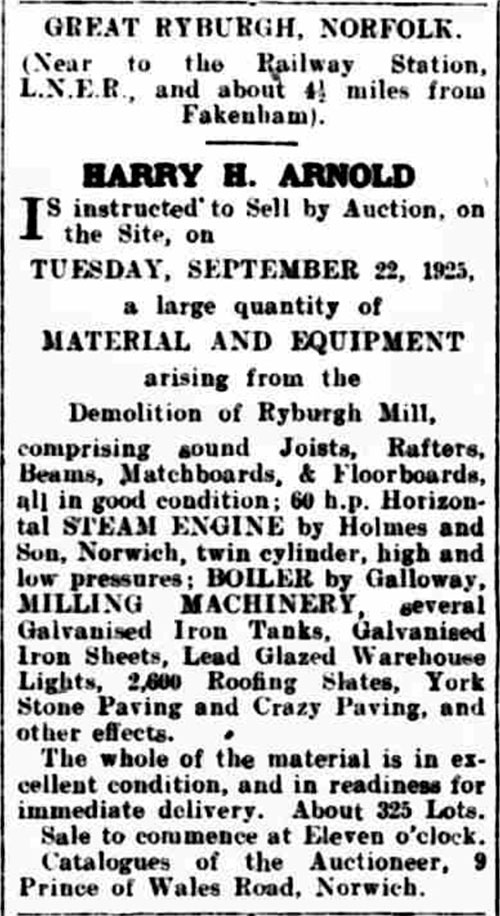 |
18th September 1925 |
This is largely heresay and speculation on my part. |
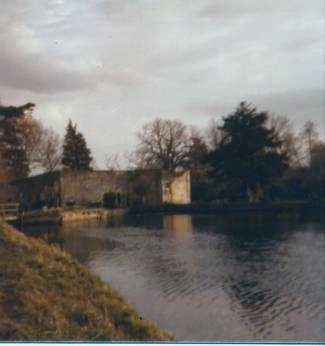 |
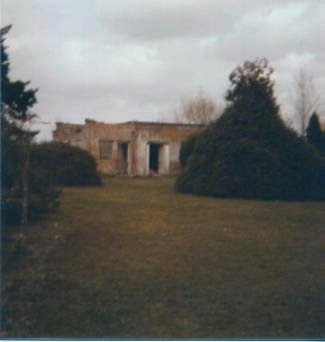 |
|
Mill
dam 1977
|
Mill
base in 1977 |
In 1964 the property was bought by Mr. D. Hayward. In 1975 Mrs. Sands became the occupier of the mill house and by 1977 was running the mill house as an old peoples' home. Strangely the mill came free with the mill house and there was no mention of it in the deeds - an oversight that has since been rectified. |
|
In 1977, Mr. Hayward said that in Elizabethan times it was reputed that the river went under the house where two arches are present. This was confirmed In 1958 when Frank Larkman wrote that there are actually the sites of two water mills standing side by side at Great Ryburgh. Of the earlier of the two mills only the waterways remain but the ground floor of the second mill still stands. |
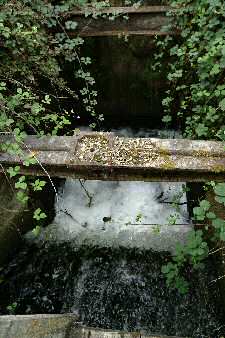 |
 |
|
Wheelrace
August 2003
|
Tailrace
25th August 2003 |
Mills |
|
6.16 The mill structures have a profound influence on the river system in the Wensum catchment. If high retained water levels continue upstream of the mills, they would form a significant constraint on the effectiveness of river restoration. Physical modifications at mill sites should aim to restore a more natural longitudinal profile to the river and to remove or reduce physical barriers to the movement of fish and wildlife. Whilst historically a number of mills have been in existence for centuries these have always very actively stored and released water and the cessation of working of the mills in combination with dredging has had a significant impact. 6.17 The recommended actions at mill structures are shown in Table 9. At a number of sites there is no mill building and removal of water level control structures would be the desired course of action. However, often there are multiple channels at a mill site and it is likely that some hydraulic controls would be needed to maintain a split of flows to all channels. These would probably take the form of a fixed crest and a natural chute that would allow the passage of fish and woody debris. At locations where the water level control structures are part of the historic mill building, there is often a variety of passageways and the best way to lower levels will need to be identified using more detailed survey. Initial action can be taken at low cost by merely adjusting operating levels using the available gates and stop boards. The reduction in head that could be achieved at a typical dry weather flow is also summarised in Table 9. The estimated maximum reduction in backwater length through changing the operational level of the sluices (that is, without the need for major engineering works) is 18km. This would reduce the length of the River Wensum SSSI affected by backwater from mills from 67% to 40%. To achieve this it would be necessary to ensure that no channels downstream of gates or fixed weirs are affected, but this could be a cost effective start to the Wensum restoration. 6.18 It is likely that at some locations, where the channel course has been altered and the mill channel is significantly higher than the natural channel, the main flow could be diverted upstream of the current mill location. Maintaining some flow to the original mill weir is likely to be preferable for aesthetic and heritage reasons, so by-passing is likely to be required in conjunction with lowering of the mill weir. Sites where such a solution is envisaged are at Great Ryburgh and Lyng. 6.19 The control structures at Costessey, Swanton Morley and Fakenham are used for flow gauging by the Environment Agency. Lowering these weirs may mean that the existing gauging arrangements will need to be replaced by other methods, such as ultrasonic techniques. The weir on the main channel at Swanton Morley has a two stage drop and a significant reduction in water level could be achieved there without affecting flow gauging through the bridge. 6.20 A former mill known as Gogg's Mill near to Fakenham was removed as part of the drainage improvement works of the 1950s. The channel upstream of the mill has narrowed significantly through the accretion of silt berms, and provides a good case study of the extent to which natural recovery can help restore natural river form and function. 6.21 As part of the River Wensum Water Level Management Plan being prepared by Entec (2007) the views of some private owners on changes in operating level have been canvassed. In broad terms this is not opposed, but there is concern to maintain an attractive setting incorporating some mill pond in line with the historical context particularly at: 1) Elsing 2) Great Ryburgh 3) Bintree 4) North Elmham 5) Lenwade. 6.22 A reduction in the retained water level at mills may constrain the ability to direct water through all the existing channels at mill sites, should this still be required, there may be a need to carry out physical modifications to some of the subsidiary water level control structures. River Wensum Restoration Strategy - Natural England, 26th June 2009 |
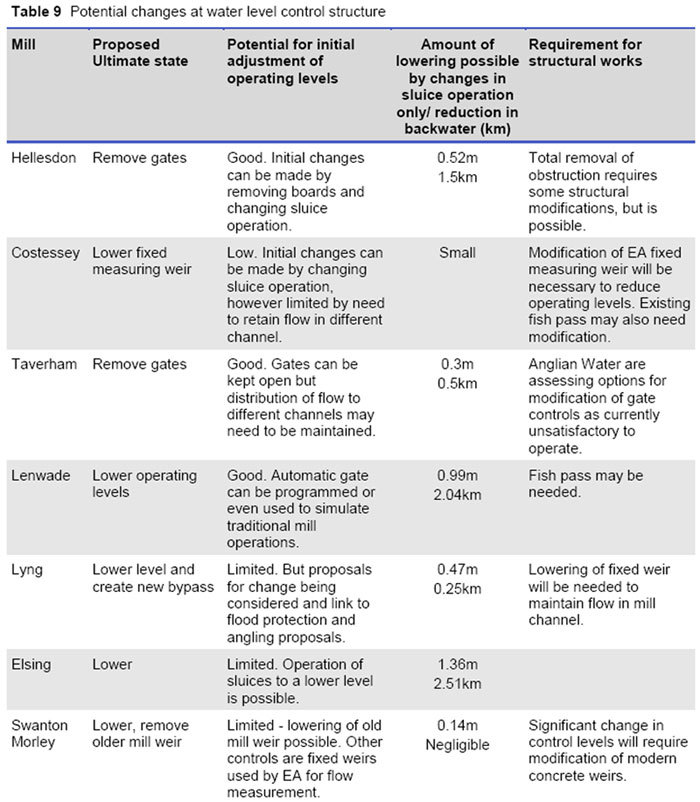
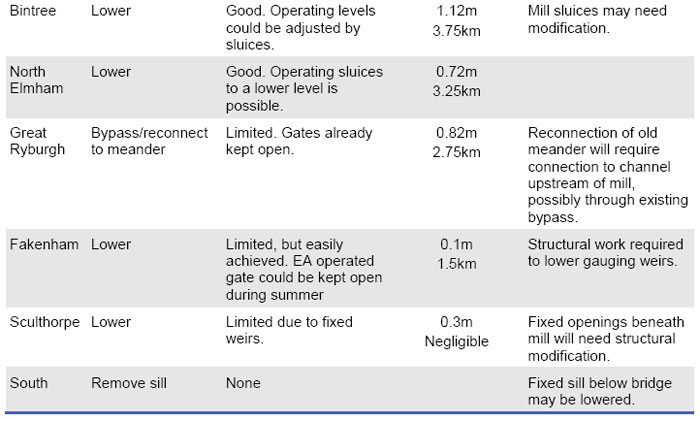
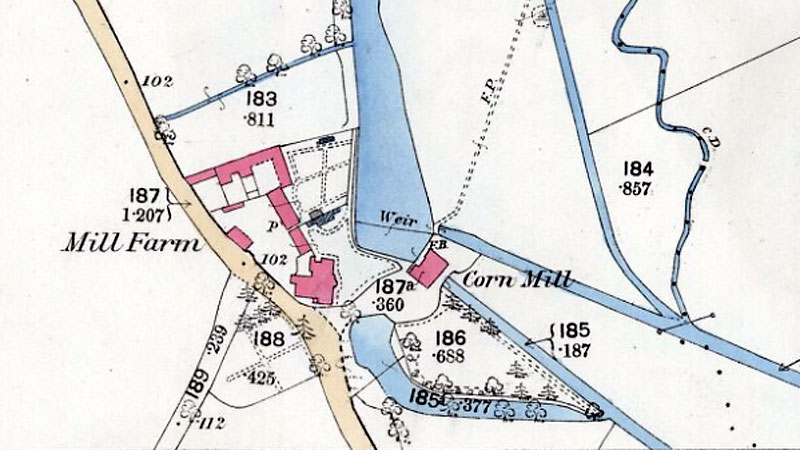 |
O. S. Map 1885 |
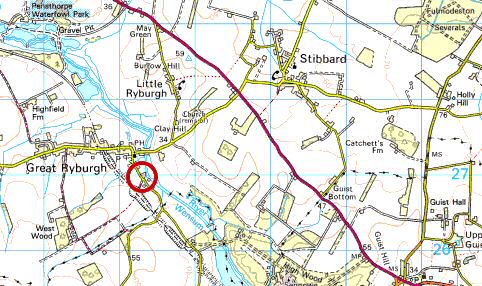 |
O.S. Map 2005 Image reproduced under licence from Ordnance Survey |
|
White's 1854: Samuel & William Osbiston, corn & coal merchants |
|
1579: Mill leased to Simon Mussett
June 1794: Joseph & Richard Bowles, millers declared bankrupt
Census 1841:
Cubitt Johnson, journeyman miller
Census 1851: William Marshall (16) b.Gt Ryburgh, miller (living with parents)
Harrod's 1863: Frederick Smith, miller
Harrod's 1872: Frederick Smith, miller
1882: James Cunnel, miller; John Ellison, miller (employees)
White's 1890: Mrs. Anne Smith, miller, cake, & c. merchant and farmer, Mill house
Kelly's 1892: F. & G. Smith Ltd.
Kelly's 1912: F. & G. Smith Ltd.
Kelly's 1922: F. & G. Smith Ltd. |
If you have any memories, anecdotes or photos please let us know and we may be able to use them to update the site. By all means telephone 07836 675369 or
|
| Nat Grid Ref TF 96412696 | Copyright © Jonathan Neville 2003 |